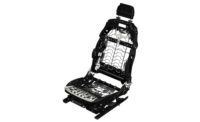World-class manufacturers maintain high standards in every facet of their business, from materials and design, to assembly, performance and customer service. Quite often, these same companies are equally committed to meeting the highest industry standards in one or more of these areas.
Ford Motor Co., for example, regularly tests front end accessory
drive (FEAD) belts at its dynamometer lab in Dearborn, MI, to make sure they conform to the SAE J2432-2012 standard (Performance Testing of PK Section V-Ribbed Belts). This standard provides accessory drive belt testing methods and includes test configurations, pulley diameters, power loads and guidance for interpreting test data.
A few years ago, Ford had SAKOR Technologies Inc. develop a custom belt noise test stand to increase the automaker’s testing flexibility. Ford needed a stand that handles belts of any length or width, and offers alignment accuracy with full control of temperature and belt tension.
Along with these functional capabilities, the stand has a high-speed AC dynamometer that precisely simulates the torque pulses from engine firing without the fuel, cooling and fire-suppression systems necessary for fired-engine testing. It also features a thermal chamber and a water mist system that mimic a wide range of environmental conditions known to have a major effect on belt noise performance.
Scott Willis, FEAD technical specialist at Ford, is impressed with the stand’s flexibility. Besides allowing Ford engineers to test in accordance with the SAE specification, the stand performs aging and durability testing, and creates axial and angular belt misalignment. Through misalignment and tilt to the pulleys—two major contributors to engine belt noise—the stand helps Ford engineers test new rubber formulations, fibrous materials and pulley-and-belt shapes designed to minimize belt chirping under several environmental conditions.
“The stand is versatile enough to adapt to further noise test development,” explains Willis, who leads SAE’s belt drive (automotive) systems committee. “It [helps] Ford continue to provide high-quality product to its customers.”
SAKOR makes three types of AC dynamometers. The four-quadrant AccuDyne series includes 5-kilowatt to 3-megawatt models used for testing active (engines, electric motors) and passive (transmissions, generators, alternators) components. Its MicroDyne units are designed for testing small motors and components with 100 watts to 5 kilowatts of power. Small engine dynamometers help engine manufacturers comply with engine testing procedures required by emission standards contained in 40 CFR Part 1065.
SAKOR has designed and built test instrumentation systems for other manufacturers besides automotive OEMs. For more information, call 517-332-7256 or visit www.sakor.com.






